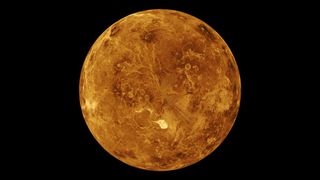
Last week, a team of researchers told the world that they had detected a molecule in the upper cloud layers of Venus typically only created by living creatures here on Earth.
The blockbuster announcement of finding phosphine in the clouds of Venus made a major splash in the news. But pushback began appearing even as details of the results were coming to light.
In the days since, scientists have had some time to articulate their criticisms, which fall into two main camps. On one side, there are those who question the detection itself and whether the team has definitely seen what they claim to have seen. And a second attack heavily scrutinizes the interpretation and whether or not life is a good conclusion to arrive at.
Related: 10 interesting places in the solar system we'd like to visit
Even those who are skeptical believe the findings to be intriguing. Venus has a hot and hellish surface, but the idea that life might exist in its relatively balmy upper atmosphere has been around for a long time. Everyone understands that this is not the final word on the matter, which is likely to take years to fully sort out.
"Obviously if it's correct, it's an extremely cool result and potentially has profound implications," John Carpenter, an observatory scientist at the Atacama Large Millimetre/submillimetre Array (ALMA) in Chile, told Live Science. "But grand claims demand grand evidence."
At the center of this debate is the molecule phosphine, or PH3, which is made from one phosphorus atom bonded to three hydrogen atoms. Phosphine is a nasty and poisonous gas for many creatures, including humans, but is produced by bacteria living in rotting sewage and swamps where oxygen is lacking, as well as in the intestines of some animals.
Get the Space.com Newsletter
Breaking space news, the latest updates on rocket launches, skywatching events and more!
Using the James Clerk Maxwell Telescope in Hawaii and ALMA, astronomers looked for telltale dips in Venus' light that would indicate the presence of different chemicals, and noticed one associated with phosphine. The result is particularly perplexing because Venus' atmosphere is full of carbon dioxide and other oxygen-containing molecules, which should rip apart phosphine in no time. To have it present in any amount is bewildering.
But did the research team really see phosphine? The observations contain a good amount of noise, which might simply be mimicking a phosphine signal, suggested Carpenter.
Michael Way, a physical scientist at NASA's Goddard Institute for Space Studies in New York City, agreed.
"More lines are needed to verify that it is this particular molecule," Way told Live Science in an email. "As this point it's not 100% clear exactly what they have measured."
In particular, Way pointed out that there is a signature associated with sulfur dioxide, SO2, at nearly the same frequency of light. Sulfur dioxide is the third most abundant gas in Venus' atmosphere, so its presence might account for the phosphine finding, David Catling, an astrobiologist at the University of Washington in Seattle, told Live Science in an email.
The team who made the original phosphine finding is interested in doing follow-up observations to verify their results. And independent investigators with NASA's Stratospheric Observatory for Infrared Astronomy (SOFIA) telescope, the Very Large Telescope in Chile, and the European Space Agency's BepiColombo spacecraft, which will soon fly past Venus on its way to Mercury, are all planning their own phosphine searches.
But even if phosphine exists on our sister world, there are many reasons to doubt that life is making it. Here on Earth, phosphine is associated with living organisms, but Venus is quite literally an alien planet, and scientists don't yet fully understand its many complex details.
Phosphine is a very simple molecule, just four atoms large, and "super easy to make in the laboratory," Lee Cronin, a chemist at the University of Glasgow in the United Kingdom, who has been vocal on Twitter about the results, told Live Science. "You just combine phosphorus and a base. I've made it by mistake."
The team who made the detection tried to think of all the possible non-living routes they could imagine for producing phosphine on Venus, releasing a 100-page paper on arxiv Sept. 14 describing their attempts, and coming up short in every case. (That paper has not yet been peer-reviewed.) But that doesn't mean there wasn't something they missed.
Cronin suggested that Venus' surface, which is thought to be geologically active, might on occasion split open, revealing underground reserves of phosphorus. Should Venus' sulfuric acid (H2SO4) clouds then send down rain, they might spark a reaction to form plumes of phosphine that could explain its presence in the atmosphere. Any number of other ways to make phosphine could also be plausible, he added.
"You set up a false narrative," Cronin said. "Phosphine is present on Venus, and phosphine has been seen in Earth biology; therefore there's life on Venus."
Moreover, the idea of Earth-like organisms, even microbial ones, living in Venus' hellish, toxic atmosphere is a tough one for many scientists. "The cloud droplets are concentrated sulfuric acid," Catling said. "Chemists know that if you add biomolecules to concentrated sulfuric acid, you'll get a vigorous reaction where the biomolecules end up looking like charcoal and deader than a doornail."
While some water is present in these clouds, it is six times less available than it is in honey, which terrestrial microbes are unable to live in, Catling added. This is the reason honey does not need to be kept in the fridge, and why it can last for thousands of years without perishing. "Life in Venus' life-killing clouds is just a hard sell," Catling said.
Figuring out just what is going on in this case is likely to take a while. "Expect a lot of interesting papers, many wrong and many correct, in the coming months," Way said.
The one thing that's certain is that Venus will be receiving a great deal more attention in the near future. For his part, Cronin believes it's possible life does exist in Venus' clouds, but that it is liable to have chemistry quite unlike terrestrial organisms. A molecule like phosphine could be a "bio-hint," he said, but would need additional information to definitively prove whether or not it’s being created by life.
"I think what these guys are doing is super interesting," he added. "I just think they should have moderated it even more judiciously."
Editor's Note: This story was updated to clarify that phosphine can be made easily in the lab by combining phosphorus with a base, not phosphorus and hydrogen. It was also corrected to note that water is six times less available the clouds of Venus, but those clouds are not six times drier.
Originally published on Live Science.
Join our Space Forums to keep talking space on the latest missions, night sky and more! And if you have a news tip, correction or comment, let us know at: community@space.com.

Adam Mann is a journalist specializing in astronomy and physics stories. His work has appeared in the New York Times, New Yorker, Wall Street Journal, Wired, Nature, Science, and many other places. He lives in Oakland, California, where he enjoys riding his bike. Follow him on Twitter @adamspacemann or visit his website at https://www.adamspacemann.com/.
-
rod Interesting report. I did not see any references to phosphine at Jupiter or Saturn in the report. In 1911, Scientific American published this about Venus being habitable.Reply
“Venus is nearly as large as the earth and, as it is much nearer the sun, its temperature must be higher than that of the earth. The average temperature is estimated to be about 140 degrees F. Various phenomena appear to indicate that the planet is surrounded by a comparatively dense and cloudy atmosphere which, indeed, is apparently seen as a luminous border, in the transits of Venus over the sun’s disk, which occur once or twice in a century. This dense atmosphere strongly reflects the sun’s rays and thus prevents the surface of the planet from attaining a temperature too elevated for highly organized life. The planet would be regarded as habitable.”
—Scientific American, March 1911", reference - News Flash: We Could Live on Venus, https://www.scientificamerican.com/article/newsflash-we-could-live-on-venus/
Apparently demonstrating that abiogenesis took place on Earth and Venus, is a work in progress going back to at least 1911 :)

